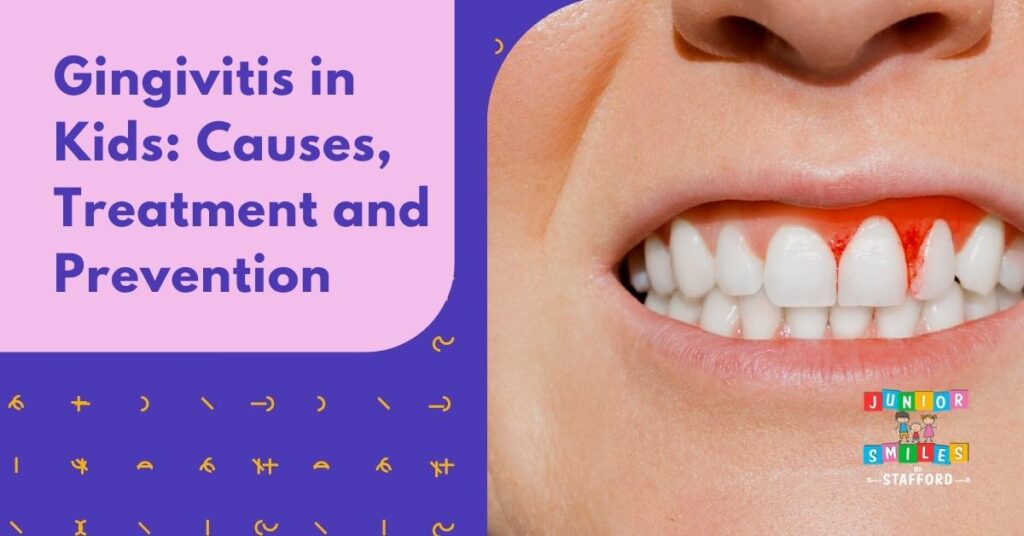Understanding and Managing Gingivitis (Gum Disease) in Kids

Your child’s dental hygiene may not be a top priority for them. But gum disease (also called gingivitis or periodontal disease) becomes increasingly common in youngsters as they become older. Luckily, gingivitis is typically easy to treat, and it’s a great chance to talk to your kids about how to take care of their teeth. If you want to know how to recognize the signs of gingivitis in children and what to do about it, this article is for you.
What is Gingivitis?
Gingivitis is a common and mild form of gum disease (periodontal disease) that causes irritation, redness, and swelling (inflammation) of the gums, especially the part of your gum around the base of your teeth, known as the gingiva. It’s important to take gingivitis seriously and treat it promptly as it can lead to much more serious gum disease called periodontitis and tooth loss. The most common cause of gingivitis is poor oral hygiene that encourages plaque to form on teeth, causing inflammation of the surrounding gum tissues. Here’s how you can tell if you have gingivitis: healthy gums are firm and pale pink and fit snugly around teeth. Signs of gingivitis include swollen or puffy gums, dusky red or dark red gums, and gums that bleed easily when you brush or floss.
Signs and Symptoms of Gingivitis in Children
Gingivitis in children can often go unnoticed due to its subtle onset, but recognizing the signs and symptoms is crucial for timely treatment. One of the earliest indications of gum disease in kids is characterized by swollen gums that may appear red or feel tender. In more advanced stages, parents might notice their child’s gum swollen around a tooth, which can be a clear sign of progressing gingivitis. For toddlers, particularly those around 2 years old, swollen gums with bad breath are common symptoms. It’s essential to be vigilant about these symptoms, as gum disease in children can progress silently, leading to more severe conditions if left untreated.
Causes of Gingivitis in Kids
There are several potential causes of gum disease, but the leading one is obviously neglecting to properly clean and floss your teeth. The Mayo Clinic states that tartar forms when plaque remains on teeth after cleaning and hardens. Only a dentist is qualified to remove tartar since it is hard, harbors germs, and requires special equipment. Gingivitis, characterized by redness, swelling, and bleeding of the gums, can develop in children whose tartar and plaque remain on their teeth. A child’s genetic predisposition to gum disease is an additional consideration when thinking about this issue in the context of family history. In addition, receding gums and other gum diseases are more common in teens because of hormonal changes that occur during this time. In order to prevent and manage gingivitis in children, it is crucial to understand these reasons.
How Do You Treat Gingivitis?
The most obvious strategy to keep children’s gums healthy and free of gingivitis is to keep plaque at bay. And here are other several ways to lessen the severity of gingivitis, avoid it altogether, and even restore its health:
Schedule Cleanings
The only person qualified to remove tartar once it has built up is the dentist. For patients suffering from gingivitis, a professional cleaning by a dental hygienist may be just what the doctor ordered. Make an appointment for your child to see a dentist for a specific cleaning if the signs of gingivitis are significant. Even so, make an appointment with the dentist at least once every six months. Following these actions can also help avoid cavities and other oral health issues.
Regular Dental Check-Ups
Regular visits to the dentist for check-ups are essential. The dentist can monitor the progress and provide guidance on the effectiveness of the treatment plan. For those with early gingivitis pictures, regular monitoring can prevent the progression of the disease.
Make Home Remedies for Gingivitis
In addition to regular oral care, certain home remedies can be effective. This includes rinsing with a warm saltwater solution to reduce gum swelling and using a mixture of baking soda and water to gently clean the gums, which can be particularly helpful for swollen bleeding gums in toddlers.
Switch to Healthy Diet
Reducing the intake of sugary and starchy foods can significantly help in treating gingivitis in toddlers. Encouraging children to eat a balanced diet rich in vitamins and minerals will promote good oral health and help in the recovery process.
Does Gingivitis Go Away on Its Own?
Gingivitis, particularly in its early stages, can often be reversed with proper dental care and oral hygiene practices. However, it’s important to understand that gingivitis does not go away on its own without intervention. The key to resolving gingivitis is removing the plaque causing the inflammation. If left untreated, gingivitis can progress to more serious forms of gum disease, which can lead to tooth loss and other health complications. For children with gum disease or early gingivitis pictures, implementing a rigorous oral hygiene routine, including thorough brushing and flossing, is essential. Regular dental check-ups are crucial for identifying and treating gingivitis early. In some cases, professional dental cleaning may be required to remove plaque and tartar build-up that can’t be cleaned away with regular brushing. Therefore, while gingivitis can be effectively treated and reversed, it requires active effort and cannot be expected to resolve on its own.
Preventing Gingivitis in Toddlers: A Parent’s Guide
Preventing gingivitis in toddlers is crucial for ensuring their long-term oral health. As a parent, you play a vital role in establishing healthy habits and routines. Here’s a guide to help you prevent gingivitis in toddlers:
Brush Their Teeth Properly
Brushing teeth is a skill that younger children require assistance with, but children over the age of five can usually do it on their own. Since no two children are exactly the same, it could be helpful to look up some pointers on how to guide your child while they brush. The most critical thing is to clean their teeth twice a day using fluoride toothpaste and a soft-bristle toothbrush.
Introduce Flossing
Begin flossing your child’s teeth daily as soon as they have two teeth that touch. This helps remove plaque and food particles from between the teeth and under the gum line. Teaching them to floss can also help them be accustomed to the routine when they grow up.
Avoid Bottle Decay
Don’t let your child go to bed with a bottle of juice or milk as it can lead to tooth decay, which in turn can promote gum disease in kids. As much as possible, your child should have already brushed their teeth before going to bed.
Monitor and Guide
Regularly check your child’s teeth and gums for any signs of red gums in toddlers or swelling, and visit the dentist if you notice any concerns. Make sure that your child does their oral hygiene routine consistently and educate them of its importance. Above all, make sure that you do your oral hygiene as well and set a good example to your child.
FAQs About Gingivitis in Kids
What is the fastest way to cure gingivitis?
The fastest way to cure gingivitis involves a combination of professional dental treatment and rigorous at-home oral care. Initially, a professional dental cleaning is crucial to remove the plaque and tartar buildup that contribute to gingivitis. Following this, maintaining a strict oral hygiene routine is essential, which includes brushing twice a day with fluoride toothpaste, flossing daily, and using an antiseptic mouthwash. Additionally, lifestyle changes such as reducing sugary food intake and regular dental check-ups can expedite the healing process. For more severe cases, especially in children, dentists might recommend specific treatments like scaling and root planing.
Which children are at risk for periodontal disease?
A higher incidence of periodontal disease is associated with children’s lack of good dental hygiene practices. Kids who eat a lot of sugary foods and drinks or who don’t have their teeth checked often are at a higher risk. Furthermore, there may be an elevated risk among children who already have pre existing diseases like diabetes or who are taking medications that alter saliva production. The hormonal changes that occur throughout puberty, in addition to a genetic predisposition, make youngsters more likely to suffer from gum disorders. In order to catch problems early and prevent them from worsening, parents should keep a close eye on their child’s dental hygiene routine and take them to the dentist often.
How is periodontal disease diagnosed in a child?
In order to identify periodontal disease in children, a dentist will look at their teeth and their medical history. If the gums are red, swollen, or bleeding during the dental appointment, it might be an indication of gum disease. Periodontal disease may be detected and assessed by measuring the depth of gaps between teeth and gums using a probe. If your dentist suspects bone loss around your teeth, he or she may recommend dental X-rays. For more information, it might be helpful to evaluate the child’s medical history, particularly for any diseases or practices that would put them at a higher risk of gum disease.
What is the most common age of gingivitis in children?
The most common age for gingivitis in children varies, but it often appears in two primary stages. The first is during the toddler years, as they begin to get their primary teeth, and parents might notice symptoms like swollen or red gums. The second peak occurs during adolescence, due to hormonal changes and increased susceptibility to plaque accumulation. Teenagers are especially prone to gingivitis due to a combination of hormonal changes, dietary habits, and sometimes inconsistent oral hygiene practices. Early intervention and education about proper dental care are essential at both these stages to prevent the onset and progression of gingivitis.
Schedule Your Child’s Dental Check-up Today!
Understanding and addressing gingivitis in children is crucial for their long-term dental health. Early detection, regular dental care, and good oral hygiene habits are key to preventing and treating gum diseases in kids. Remember, the health of your child’s teeth and gums plays a significant role in their overall well-being.
If you’re concerned about your child’s oral health or looking for a reliable dental clinic, consider Junior Smiles of Stafford. As a trusted dental clinic for kids in VA., we specialize in pediatric dentistry, offering a friendly and caring environment tailored to meet the unique needs of your child. From routine check-ups to more specialized treatments, our team of experienced dental professionals is committed to ensuring your child’s smile stays bright and healthy.

